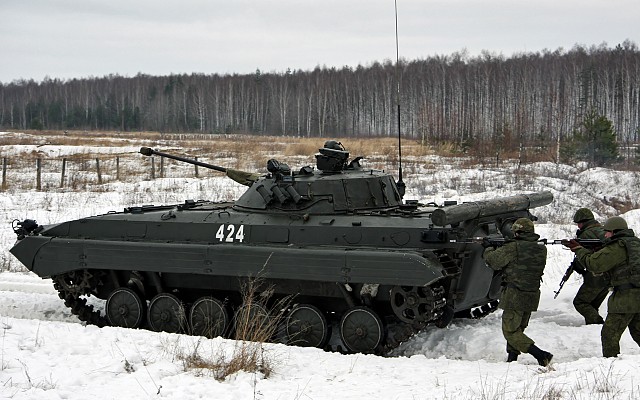BMP-2
Overview

BMP-2
BMP-2 in Finnish military service. Note that this vehicle is in original configuration and that Finland employs modernized versions of the BMP-2 as well.
Source: Unknown author -
© Copyright lies with original owner
1987 - 2007 (Indian production)
Czechoslovakia - ZTS
India - Ordnance Factory Medak
Czech production and service
BWP-2
Polish service
Sarath
Indian production and service
Obyekt 675
GABTU index
BMP-2E
Incorrect name for BMP-2D
Description
Introduction
The BMP-2 is a mechanized infantry fighting vehicle of Russian origin. It is a more combat capable version of the earlier BMP-1. The BMP-2 was developed in the late 1970's after combat experience with the BMP-1 during conflicts in the Middle East.
Layout
The BMP-2 retains the overall layout of the BMP-1 as roughly the same chassis is used. The main improvements over the BMP-1 are the two man turret, which now also houses the commander, and the improved armament. Due to the larger turret the troop capacity is reduced from eight to seven. The armor package was slightly improved, but remains quite similar to the BMP-1.
Firepower
The main armament is the powerful 30mm 2A42 dual feed autocannon. It has a cyclic rate of fire of either 200 to 300 rounds per minute or 550 rounds per minute. The latter fire mode is hardly used. The effective range is 1.5 km against vehicles and about 2.5 km against slow moving helicopters and soft targets. A 7.62mm PKT machine gun is mounted as a coaxial weapon. Additionally there is a 9P135 missile launcher on the roof which is able to fire both 9M113 Konkurs (AT-5 Spandrel) and 9M111 Fagot (AT-4 Spigot) anti-tank missiles.
Protection
The BMP-2 has a slightly improved armor package compared to the BMP-1. Over the frontal arc there is protection against 12.7mm rounds and the sides and rear at able to withstand small arms fire. Some BMP-2's have been fitted with add-on armor. An NBC system is standard and six smoke grenade launchers are fitted on the turret.
Mobility
The tracked chassis provides the BMP-2 with a good cross country performance. A 300hp diesel engine provides propulsion. The BMP-2 is fully amphibious by raising the trim vane and is propelled in the water by its tracks.
Users
The BMP-2 was mainly used by the Soviet army during the Cold War. Adoption in Eastern Europe varied. The BMP-2 was also widely exported to Soviet allies. Despite the much improved firepower over the BMP-1 it wasn't produced in similar numbers, mainly due to the break up of the USSR.
Variants

BMP-2
Forward view of Russian BMP-2 on exercise in 2011.
Source: Vitaly V. Kuzmin -
© GNU Attribution Share Alike license
Variants of the BMP-2
BMP-2 obr 1980: Initial production model.
BMP-2 obr 1984: Model with improved turret armor.
BMP-2 obr 1986: Model with newer BPK-2-42 gun sight.
BMP-2D: Uparmored BMP-2 with applique armor on turret and 6 mm thick side skirts.
BMP-2K: Command variant with additional long range radios and a crew of 6.
Details
Media
Subcomponents

BMP-2
Russian army BMP-2 on display in 2011.
Source: Vitaly V. Kuzmin -
© GNU Attribution Share Alike license
Armament of the BMP-2
Related articles

BMP-2M
The BMP-2M is an upgrade package for existing BMP-2. It is fitted with the improved Berezhok turret which includes the Kornet anti-tank missile and AGS-17 automatic grenade launcher.

BMP-1
The BMP-2 is a modernized and improved version of the BMP-1. Both vehicles share many automotive components, but the BMP-2 feature a new and larger turret.













